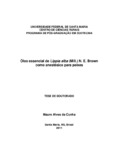| dc.creator | Cunha, Mauro Alves da | |
| dc.date.accessioned | 2011-02-23 | |
| dc.date.available | 2011-02-23 | |
| dc.date.issued | 2011-01-14 | |
| dc.identifier.citation | CUNHA, Mauro Alves da. Essential oil of Lippia alba as anaesthetic and antibacterial for fish. 2011. 78 f. Tese (Doutorado em Zootecnia) - Universidade Federal de Santa Maria, Santa Maria, 2011. | por |
| dc.identifier.uri | http://repositorio.ufsm.br/handle/1/4321 | |
| dc.description.abstract | There are some effective anesthetics and antibacterial for fishes, but it is important to search new alternatives of substances easily obtained, of low cost for fish farmers and with no risk to fish and human health. Therefore, this study analyzed the use of essential oil (EO) of Lippia alba as anesthetics, in silver catfish (Rhamdia quelen) and slender seahorse (Hippocampus reidi).To identify time of induction and anesthesia recovery, the fishes were placed in aquaria containing different concentrations of EO and after induction, fish were transferred to anesthetic-free aquaria to evaluate recovery time. Blood collect of the fish for analysis of plasma cortisol (silver catfish) and Blood glucose levels (seahorse). In silver catfish blood was collected 0, 1 and 4 h after anesthesia and air exposure and some epecimens
were killed at time 0h for sensorial evaluation of the fillet. In slender seahorses blood was collected begin and after the transport of the 4 our 24 h. The results obtained
showed that the EO could be used at concentrations ranging from 100 to 500 mg L−1 to induce anesthesia (stage 4) in silver catfish, as it reduces plasma cortisol when the
fish is exposed to air, and does not modify the odor and the flavor of the fillet. In seahorses this EO is effective to induce slight sedation in slender seahorse at 10-20 μL L-1and deep anesthesia at 50 450 μL L-1. Furthermore, 15 μL L-1 of EO in the water of transport inhibits elevation of blood glucose and neutrophils and
lymphocytes decrease in slender seahorse, and therefore its use in the transport of this species is suggested. | eng |
| dc.description.sponsorship | Coordenação de Aperfeiçoamento de Pessoal de Nível Superior | |
| dc.format | application/pdf | por |
| dc.language | por | por |
| dc.publisher | Universidade Federal de Santa Maria | por |
| dc.rights | Acesso Aberto | por |
| dc.subject | Rhamdia quelen | por |
| dc.subject | Hippocampus reidi | por |
| dc.subject | Anestesia | por |
| dc.subject | Transporte | por |
| dc.subject | Estresse | por |
| dc.subject | Rhamdia quelen | eng |
| dc.subject | Hippocampus reidi | eng |
| dc.subject | Transport stress | eng |
| dc.title | Óleo essencial de Lippia alba como anestésico e antibacteriano para peixes | por |
| dc.title.alternative | Essential oil of Lippia alba as anaesthetic and antibacterial for fish | eng |
| dc.type | Tese | por |
| dc.description.resumo | Existem alguns anestésicos e antibacterianos efetivos para peixes, mas é importante buscar novas alternativas de substâncias de fácil aquisição e baixo custo aos piscicultores e que não ofereçam aos animais e manipuladores riscos à saúde. Portanto, este trabalho verificou a utilização do óleo essencial de Lippia alba (OE) como anestésico em jundiás (Rhamdia quelen) e em cavalos marinhos (Hippocampus reidi). Para identificar o tempo de indução e recuperação anestésica
os peixes foram colocados em aquários com 1 L de água contendo diferentes concentrações do OE, e após a indução, foram transferidos para aquários livres do OE para avaliar o tempo de recuperação. Foi realizada coleta de sangue dos peixes para análise de cortisol plasmático (jundiá) e glicose sanguínea (cavalo marinho). Em jundiás o sangue foi coletado 0, 1 e 4 h após anestesia e exposição ao ar e alguns exemplares do tempo 0 h foram abatidos para testes de avaliação sensorial do filé. Nos cavalos marinhos o sangue foi coletado antes e após transporte realizado por 4 ou 24 horas. Os resultados obtidos mostraram que o OE é uma
alternativa segura como anestésico para o jundiá na concentração de 100 a 500 mg L−1, pois reduz o cortisol plasmático no momento da exposição ao ar e não deixa
odor ou sabor desagradável ao filé. Em cavalos marinhos este OE mostrou-se efetivo para sedação (10-20 μL L-1) e para anestesia profunda (50 450 μL L-1). Além disso, 15 μL L-1 do OE na água do transporte inibe a elevação da glicose sanguínea e conseqüentemente seu uso no transporte desta espécie é sugerido. | por |
| dc.contributor.advisor1 | Baldisserotto, Bernardo | |
| dc.contributor.advisor1Lattes | http://lattes.cnpq.br/1036046601275319 | por |
| dc.contributor.referee1 | Vargas, Agueda Palmira Castagna de | |
| dc.contributor.referee1Lattes | http://lattes.cnpq.br/1383126157031968 | por |
| dc.contributor.referee2 | Heinzmann, Berta Maria | |
| dc.contributor.referee2Lattes | http://lattes.cnpq.br/0786124562427815 | por |
| dc.contributor.referee3 | Gomes, Levy de Carvalho | |
| dc.contributor.referee3Lattes | http://lattes.cnpq.br/3105720686893127 | por |
| dc.contributor.referee4 | Pavanato, Maria Amália | |
| dc.contributor.referee4Lattes | http://lattes.cnpq.br/8701892865724171 | por |
| dc.creator.Lattes | http://lattes.cnpq.br/9745413680917763 | por |
| dc.publisher.country | BR | por |
| dc.publisher.department | Zootecnia | por |
| dc.publisher.initials | UFSM | por |
| dc.publisher.program | Programa de Pós-Graduação em Zootecnia | por |
| dc.subject.cnpq | CNPQ::CIENCIAS AGRARIAS::ZOOTECNIA | por |


